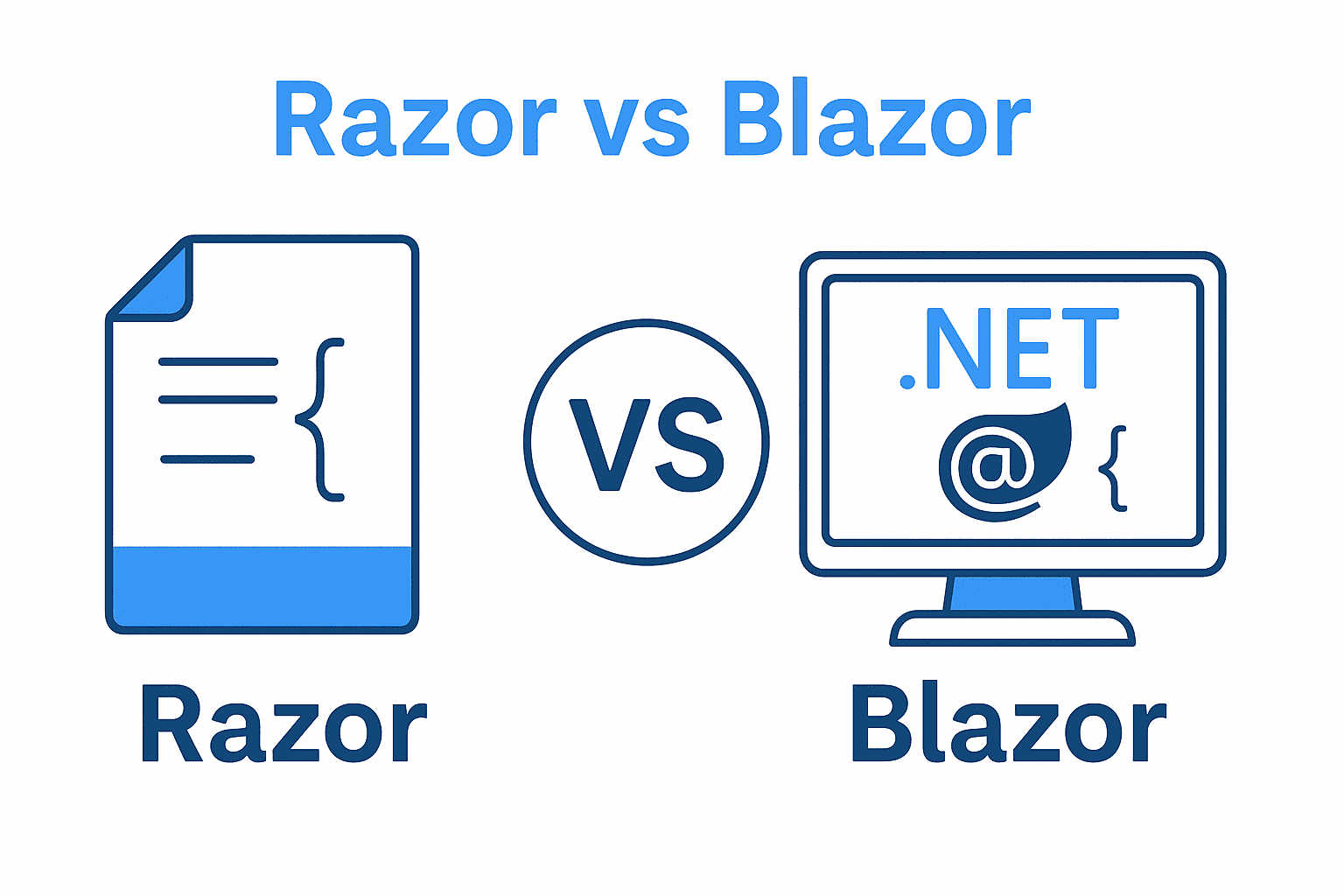If you're building web applications with .NET, you've likely come across two names: Razor and Blazor. While they sound similar, they serve different purposes.
In this guide, you'll learn the key differences between Razor and Blazor, when to use each, and how they relate in the .NET ecosystem.
What Is Razor?
Razor is a server-side markup syntax used in ASP.NET and ASP.NET Core. It lets you write HTML and C# in the same file.
Key Features:
- Uses
.cshtmlfiles - Executes on the server
- Great for SEO and fast page loads
- Ideal for multi-page applications
- Requires full-page reloads for updates
Common Use Case:
You're building a traditional website where content is rendered on the server and sent to the client as static HTML.
What Is Blazor?
Blazor is a modern UI framework for building interactive web applications using C# instead of JavaScript.
Key Features:
- Uses
.razorfiles (component-based) - Can run in the browser (Blazor WebAssembly) or on the server (Blazor Server)
- Enables real-time interactivity without JavaScript
- Supports Single Page Applications (SPA)
- Built on top of Razor syntax
Common Use Case:
You’re building a dynamic front-end app that needs real-time updates, fast interactions, and rich UI—without writing JavaScript.
Razor vs Blazor: Side-by-Side Comparison
| Feature | Razor Pages | Blazor |
|---|---|---|
| Rendering | Server-side | Server-side or Client-side (WASM) |
| Syntax | Razor (.cshtml) | Razor (.razor components) |
| Page Updates | Full reload | Real-time UI updates |
| Interactivity | Limited (via JS) | High (via C# components) |
| SEO Support | Excellent | Depends on hosting model |
| JS Dependency | Yes (for rich UI) | Optional |
| App Type | Multi-page web apps | SPA or hybrid apps |
| Component-based UI | No | Yes |
When Should You Use Razor?
Use Razor when you:
- Need fast server-side rendering
- Care about SEO and accessibility
- Are building multi-page apps
- Want to avoid complex front-end logic
Example Scenarios:
- Company websites
- Content-heavy blogs
- Simple CRUD admin panels
When Should You Use Blazor?
Use Blazor when you:
- Want to build interactive UIs
- Prefer using C# over JavaScript
- Need a SPA-like experience
- Plan to reuse UI components
Example Scenarios:
- Internal dashboards
- E-commerce apps with dynamic filters
- Real-time collaboration tools
Developer Insights
Many developers transitioning from JavaScript frameworks (like React or Angular) enjoy Blazor for its:
- Component model
- Type safety with C#
- Ease of integration in .NET backends
However, Blazor Server can struggle on poor connections due to its reliance on SignalR, while Blazor WebAssembly has larger initial payloads but runs entirely in the browser.
Razor and Blazor: How They Work Together
Blazor actually uses Razor syntax under the hood. Here's the difference:
- Razor = templating engine
- Blazor = UI framework using Razor for components
So they’re not opposites—they’re part of the same ecosystem.
Conclusion
Choosing between Razor and Blazor depends on what you're building:
- Choose Razor Pages if you want simplicity, server-side rendering, and SEO.
- Choose Blazor if you need interactivity, modern SPA capabilities, and component-based UI—all using C#.
Both are powerful. The best choice? Depends on your project goals.
Recommended Reading
- ASP.NET Core Razor Pages Documentation
- Blazor Documentation
- Razor vs Blazor: Full Comparison (Telerik)
🤝 Need a Custom RSVP System or Dashboard?
I help businesses build tools that actually work — even on tight deadlines.
Whether you're planning an event, need internal tools, or want a custom dashboard for your team — I can help.
Reach out:
📧 Email: safi.abdulkader@gmail.com | 💻 LinkedIn: @abdulkader-safi | 📱 Instagram: @abdulkader.safi | 🏢 DSRPT
Drop me a line, I’m always happy to collaborate! 🚀


